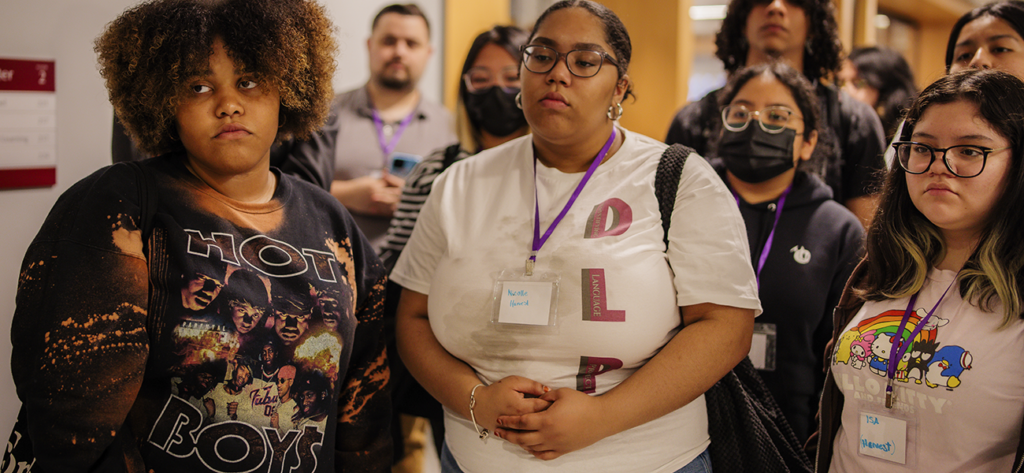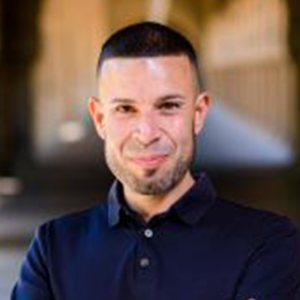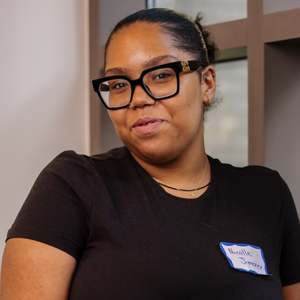Pictured above: DLP student interns displaying “rock on” in ASL by extending their index and pinky fingers while holding their middle and ring fingers down with the thumb.
How would you feel if somebody told you that you didn’t know any language? This is exactly what happened to Tamara, a Latina student who was born and raised in a bilingual home in the Bronx. Although Tamara used English every day both inside and outside of school her whole life, she was still required to take English as a Second Language (ESL) classes in high school. She used Spanish every day as well, but she was also required to take beginner Spanish classes where the Spanish she learned at home was constantly corrected. So, let’s get this straight—a bilingual Latina student is placed into ESL classes and beginner Spanish classes even though she uses English and Spanish literally all the time? That makes no sense at all!
Unfortunately, Tamara is not alone. Our insights come from our experiences as researchers studying language learning in K–12 education, teachers working in K–12 schools, and students whose language use has been policed and who have been recruited to police the language of others. Across linguistically and racially diverse contexts, we have found that the language use of students of color is continually framed as a problem. And this isn’t just about bilingualism. Students of color who only use English also often engage in a range of different forms of English when talking to friends, others in their community, and in school. Like Tamara, these students’ linguistic skills are also framed as a problem in schools. For example, one San Francisco high school teacher described her African American students as constantly engaging in incorrect forms of English and as lacking the ability to conform to standard grammar rules that are valued in school. But these students used what is typically called “Standard English” both inside and outside of the classroom all the time. That’s right! African American students who regularly use Standard English are still described by their teachers as lacking Standard English skills. What is going on here and what does this mean for the education of students of color?
Bilingualism is perceived as a talent for white students and as a deficit for students of color.
Education researchers have often offered two main explanations and solutions for what’s going on here: subtractive education, which replaces students’ home language with standard language practices, and additive education, which adds standard language practices to the home language practices that students already use. These two approaches are thought of as opposites in the field. But when we took a closer look at how researchers describe both of these approaches, we noticed that both assumed that the primary challenge confronting students of color is that they do not know the standard language practices that are talked about as the most appropriate and necessary for professional success. They both offer the same solution as well: teach students of color these standard language practices, and people will listen to and respect them. But as we saw above with Tamara, this doesn’t always happen. Let’s look more closely at both subtractive and additive education to see how both put the responsibility on students of color to change their language practices while ignoring the real problem: racism.
Advocates for subtractive education argue that language diversity is a problem and that the solution is to eliminate language diversity so that everybody communicates in the same way. The idea is that if everybody just communicated the same, we wouldn’t have these problems anymore. So how would they explain what is happening to Tamara? They would argue that the problem is that Tamara hasn’t fully replaced her home language practices—the ways that she learned to speak at home and in her community—with standard language practices valued in school. This approach is pretty racist and has negative effects on students of color. After all, it can be hard to focus on schoolwork when your teacher is telling you that the way that your family speaks is a problem, right?
Advocates of additive education see value in the home language practices of students of color. Their idea is that these home language practices do not need to be replaced but that it is still important for students of color to learn standard language practices framed as appropriate in mainstream school and professional settings. They would offer a seemingly different explanation for what is happening to Tamara. They would argue that Tamara’s home language practices are appropriate for home and in her community but that she has not fully learned the standard language practices that are appropriate for school and other professional settings. They would argue that she doesn’t have to replace her home language practices but rather learn to use standard language practices when appropriate in school and other professional settings. Advocates of additive education argue that it is anti-racist and will empower students of color. But is this approach really anti-racist? We say no.
So, what’s the issue with this approach, which seems to value students’ home language practices more than subtractive education? Our major beef with additive education is that it assumes that language is the primary challenge confronting students of color and the solution to their racial oppression is for them to successfully change their language practices when appropriate. But the problem is not with students of color, who have incredible linguistic talents. The problem is the perception of their language skills based on ideas about race. We call these perceptions that frame the language practices of people of color as always needing to be corrected, raciolinguistic ideologies. Attention to raciolinguistic ideologies shifts the focus away from what the speaker is doing to what the listener is perceiving. When we do this, we begin to see that the same linguistic practices can be perceived quite differently if the speaker is white versus if they are a person of color.
It is impossible to add enough language practices when educators have already decided that no matter what you say, your racial position means you can’t use language appropriately. We need a different solution.
We see this in the case of Estela, a Latina born and raised in Texas who, like Tamara, grew up speaking both English and Spanish. She was so passionate about her bilingualism that she decided to pursue a college degree in Spanish and then continue doctoral studies in Spanish literature. So, she grew up speaking Spanish, had a college degree in Spanish, and was now pursuing another degree in Spanish. And guess what? Her professors still thought her Spanish wasn’t good! To make matters worse, when they were asked what was wrong with her Spanish they couldn’t even say. They just thought it didn’t sound right and that her white classmates who only started learning Spanish in high school knew Spanish better than she did. It would appear that not all bilingualism is the same! Bilingualism is perceived as a talent for white students and as a deficit for students of color.
Additive education can’t fix this. It might even make matters worse. Supporters of additive education might tell these professors that Estela needs to learn how to use “standard Spanish” when appropriate in the classroom. But there is no way you are going to convince us that somebody who is pursuing a doctoral degree in Spanish literature doesn’t already know how to use standard Spanish, especially when her professors can’t even describe what she is doing that sounds so wrong to them. The problem isn’t her Spanish but the fact that she is a U.S.-born Latina student. The problem is the perceptions of her Spanish because of her racial position. Additive education doesn’t help with this situation at all. It is impossible to add enough language practices when educators have already decided that no matter what you say, your racial position means you can’t use language appropriately. We need a different solution.

Demystifying Language Project participants. Credit: Sistah Studios
Instead of trying to teach students of color to use appropriate language, we need to challenge the idea of appropriateness altogether. Appropriateness is basically just a nice way of saying “acting like a white person.” But guess what? If you aren’t white, you might never be seen or heard as a white person no matter how much you try to act and talk like one. So rather than trying to get students of color to act white, how about we teach them to challenge whiteness? To do this, we have to move away from trying to change their language practices and support them in challenging racism both in schools and the broader society.
Instead of trying to teach students of color to use appropriate language, we need to challenge the idea of appropriateness altogether.
That sounds like a big project, right? It is! But that doesn’t mean that educators should just give up. There is so much they can do to help in this struggle against societal racism. And since language is so important in creating racism, it can also be important in struggles against it. Educators can start by challenging their own perceptions of their students of color. This will help them to see that students already use many of the standard language practices valued in school both inside and outside of the classroom every day. This would open up conversations where students critically reflect on the relationship between language and power. Some scholars call these efforts critical language awareness.
Critical language awareness is just the beginning. Once we reject that the goal of education is to add standard language practices to the existing language practices of students of color and teach them to use them when appropriate, we can develop a new goal. This goal would be to support students of color in transforming language in ways that allow them to bring their whole identities into school-related tasks and assignments. That’s right! Rather than expecting students of color to act white, we can support them in the development of their own unique voices that reflect their racial and cultural backgrounds. This might sound simple enough, but what we are calling for is a radical transformation of what counts as appropriate, who decides this, and for what purposes.
Rather than expecting students of color to act white, we can support them in the development of their own unique voices that reflect their racial and cultural backgrounds.
But this radical transformation can’t happen just in the classroom. We have to connect undoing language appropriateness with broader efforts to challenge societal racism in contexts such as housing, employment, health care, criminal justice, the environment, immigration, and electoral politics. However, classrooms are still an important place for these struggles, especially once we reject the idea that students of color and their language practices need to be fixed and instead acknowledge that it’s racism that needs to be fixed. Tamara is not the problem. Estela is not the problem. Students of color are not the problem. Language is not the problem. Racism is the problem. Period.




